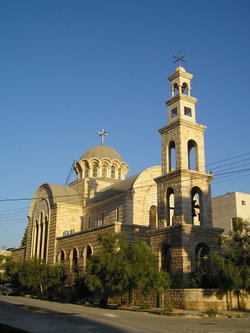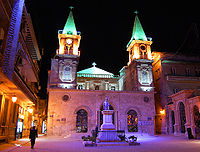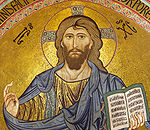- Christianity in Syria
-
Christians in Syria make up about 10% of the population,[1] the largest Christian denomination is the Greek Orthodox Church of Antioch,[2][3][4] closely followed by the Melkite Greek Catholic Church, and then the Syriac Orthodox Church; there are also a minority of Protestants. Mainly, the city of Aleppo is believed to have the largest number of Christians in Syria.
The President of Syria has to be a Muslim, as a result of popular demand at the time the constitution was written. However, Syria does not profess a state religion, and does not officially favor any religion over another.
Contents
Status of Christians in Syria
Damascus was one of the first regions to receive Christianity during the ministry of St Paul. There were more Christians in Damascus than anywhere else. After the military expansion of the Umayyad empire into Syria and Anatolia, the teachings of Islam came into practice and many became Muslims.
Nowadays, Damascus still contains a sizeable proportion of Christians, with churches all over the city, but particularly in the district of Bab Touma. Masses are held every Sunday and civil servants are given Sunday mornings off to allow them to attend church, even though Sunday is a working day in Syria. Schools in Christian-dominated districts have Saturday and Sunday as the weekend, while the official Syrian weekend falls on Friday and Saturday.
In May 2011, International Christian Concern indicated that Christians in Syria were more afraid of the anti-government protesters than of the government itself, because under the Syrian Assad government there has been tolerance towards religious minorities.[5][6]
Integration
Christians (as well as the few remaining Jews in the country) engage in every aspect of Syrian life. Following in the traditions of Paul, who practiced his preaching and ministry in the marketplace, Syrian Christians are participants in the economy, the academic, scientific, engineering, arts, and intellectual life, the entertainment scene, and the political arena of Syria. Many Syrian Christians are public sector and private sector managers and directors, while some are local administrators, members of Parliament, and ministers in the government. A number of Syrian Christians are also officers in the armed forces of Syria. They have preferred to mix in with Muslims rather than form all-Christian units and brigades, and fought alongside their Muslim compatriots against Israeli forces in the various Arab-Israeli conflicts of the 20th century. In addition to their daily work, Syrian Christians also participate in volunteer activities in the less developed areas of Syria. As a result, Syrian Christians are generally viewed by other Syrians as an asset to the larger community.
Separate
Syrian Christians have their own courts that deal with civil cases like marriage, divorce and inheritance based on Bible teachings. By agreement with other communities, Syrian Christian churches do not proselytise to Muslims and do not accept converts from Islam. Noteworthy Syrian Christians include the chronicler Paul of Aleppo, the chess player Philip Stamma, and the Syrian Armenian musician George Tutunjian.
 The old Christian quarter of Jdeydeh, Aleppo
The old Christian quarter of Jdeydeh, Aleppo
Origins
Part of a series on Eastern Christianity 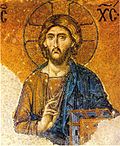
History Orthodox Church History
Specific regions:
Byzantine Empire
Ecumenical council
Christianization of Bulgaria
Christianization of Kievan Rus'
East-West Schism
Asian Christianity
Coptic Egypt · UkraineTraditions Orthodox Church
Others:
Oriental Orthodoxy
Ethiopian Tewahedo Church
Coptic Church
Church of the East
Eastern Catholic Churches
Syriac ChristianityLiturgy and worship Sign of the cross
Divine Liturgy
Iconography
Asceticism
OmophorionTheology Hesychasm · Icon
Apophaticism
Filioque clause
Miaphysitism
Monophysitism
Diophysitism
Nestorianism
Theosis · Theoria
Phronema · Philokalia
Praxis · Theotokos
Hypostasis · Ousia
Essence vs. Energies
Metousiosis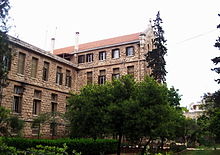 The Monastery of the Franciscan Missionaries of Mary in Aleppo
The Monastery of the Franciscan Missionaries of Mary in Aleppo
The Christian communities of Syria, which comprise about 10 percent of the population,[1] spring from two great traditions. On the one hand, Roman Catholicism and Protestantism were introduced by missionaries and a small number of Syrians are members of Western denominations. The vast majority, on the other hand, belong to the Eastern communions, which have existed in Syria since the earliest days of Christianity. The main Eastern groups are:
- the autonomous Orthodox churches;
- the Uniate churches, which are in communion with Rome;
- and the independent Assyrian Church of the East, which in the past, western scholars labeled "Nestorian". Followers of the Assyrian Church of the East are almost all ethnic Assyrians/Syriacs, as are some Orthodox and Catholic Christians. Even though each group forms a separate community, Christians nevertheless cooperate increasingly.
The schisms that brought about the many sects resulted from political and doctrinal disagreements. The doctrine most commonly at issue was the nature of Christ. In 431, the Nestorians were separated from the main body of the Church because of their belief in the dual character of Christ, i.e., that he had two distinct but inseparable "qnoma" (ܩܢܘܡܐ, close in meaning to, but not exactly the same as, hypostasis), the human Jesus and the divine Logos. Therefore, according to Nestorian belief, Mary was not the mother of God but only of the man Jesus. The Council of Chalcedon, representing the mainstream of Christianity, in 451 confirmed the dual nature of Christ in one person; Mary was therefore the mother of a single person, mystically and simultaneously both human and divine. The Miaphysites taught that the Logos took on an instance of humanity as His own in one nature. They were the precursors of the present-day Syrian and Armenian Orthodox churches.
By the thirteenth century, breaks had developed between Eastern or Greek Christianity and Western or Latin Christianity. In the following centuries, however, especially during the crusades, some of the Eastern churches professed the authority of the pope in Rome and entered into or re-affirmed communion with the Catholic Church. Today called the Eastern Catholic churches, they retain a distinctive language, canon law and liturgy.
Greek Orthodox church
The largest Christian denomination in Syria is the Greek Orthodox church, formerly known as the Melkite church after the 5-6th centuries Christian split, in which they stayed loyal to Constantinople ("melek" = king, is the Aramaic denomination for the Byzantine Emperor). The appellation "Greek" refers to the liturgy they use, sometimes used to refer to the ancestry and ethnicity of the members, however not all members are of Greek ancestry; in fact the Arabic word used is "Rum", which means "Byzantines", or Eastern Romans. Overall, the term is generally used to refer mostly to the Greek liturgy, and the Greek Orthodox denomination in Syria. Arabic is now its main liturgical language.
Syriac Orthodox church
The Syriac Orthodox or Jacobite church, whose liturgy is in Syriac, was severed from the favored church of the Byzantine Empire (Eastern Orthodoxy), over the Chalcedonian controversy.
Armenian apostolic church
The Armenian Apostolic Church is the second largest Oriental Orthodox Christian group. It uses an Armenian liturgy and its doctrine is Miaphysite (not monophysite, which is a mistaken term used or was used by the Chalcedonian Catholics and Orthodox).
Eastern Catholic churches
Of the Eastern-rite Catholic churches (known as "Uniate" because they united to Rome, although they themselves reject this denomination as pejorative) the oldest is the Maronite, with ties to Rome dating at least from the twelfth century. Their status before then is unclear, some claiming it originally held to the Monothelite heresy up until 1215, while the Maronite Church claims it has alway been in union with Rome. The liturgy is in Syriac.
The Patriarchate of Antioch never recognized the mutual excommunications of Rome and Constantinople of 1054, so it was canonically still in union with both. After a disputed patriarchal election in 1724, it divided into two groups, one in union with Rome and the other with Constantinople. Today the term "Melkite" is in use only among the Greek Catholics. Like the Greek Orthodox Church, the Melkite Greek Catholic Church uses Greek and Arabic. Their membership is entirely ethnic Arabs.
Christians and Muslims
In Syria, there are several social differences between Christians and Muslims. Throughout the history, Syrian Christians were more highly urbanized than Muslims; many live either in or around Aleppo, Hamah, or Latakia, and there were relatively fewer of them in the lower income groups.[7] Proportionately more Christians than Muslims are educated beyond the primary level,[citation needed] and there are relatively more of them in white-collar and professional occupations.[8]
Christian areas
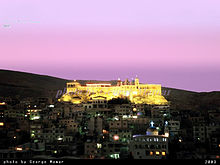 Saidnaya convent at night.
Saidnaya convent at night.
Christians spread throughout Syria and they are a majority in some provinces; important areas are
- Aleppo, where the largest Armenian population resides.
- Damascus contains a sizable Christian community.
- Homs, which has the second largest Christian population known, especially in the nearby Valley of Christians, a popular tourism site close to the Crac des Chevaliers;
- Saidnaya;
- Tartous;
- Latakia
- Suwayda;
- and Al-Hasakah, which has a large ethnic Assyrian/Syriac population.
See also
- Religion in Syria
- List of Monasteries in Syria
- Roman Catholicism in Syria
- List of churches in Aleppo
Notes
- ^ a b According to CSI World Factbook.https://www.cia.gov/search?NS-search-page=document&NS-rel-doc-name=/library/publications/the-world-factbook/print/sy.html&NS-query=syria&NS-search-type=NS-boolean-query&NS-collection=Everything&NS-docs-found=1076&NS-doc-number=2
- ^ http://atheism.about.com/library/FAQs/islam/countries/bl_SyriaChristianity.htm
- ^ Bailey, Betty Jane; Bailey, J. Martin (2003). Who Are the Christians in the Middle East?. Grand Rapids, Michigan: William B. Eerdmans. p. 191. ISBN 0802810209.
- ^ http://www.state.gov/g/drl/rls/irf/2008/108493.htm
- ^ "Syria: Activists set free to promote for National Dialogue". DayPress. May 16, 2011. http://www.dp-news.com/en/detail.aspx?articleid=84001. Retrieved June 11, 2011.
- ^ Charlie Butts (May 16, 2011). "Anti-gov't protesters after Syrian Christians". OneNewsNow.com. http://www.onenewsnow.com/Persecution/Default.aspx?id=1346594. Retrieved June 11, 2011.
- ^ Saint Terzia Church in Aleppo Christians in Aleppo (in Arabic)
- ^ BBC News Guide: Christians in the Middle East, last update 15 December 2005.
Christianity by Country
North AmericaSouth AmericaOceaniaReferences
 This article incorporates public domain material from websites or documents of the Library of Congress Country Studies.
This article incorporates public domain material from websites or documents of the Library of Congress Country Studies.Christianity in Asia Sovereign
states- Afghanistan
- Armenia
- Azerbaijan
- Bahrain
- Bangladesh
- Bhutan
- Brunei
- Burma (Myanmar)
- Cambodia
- People's Republic of China
- Cyprus
- East Timor (Timor-Leste)
- Egypt
- Georgia
- India
- Indonesia
- Iran
- Iraq
- Israel
- Japan
- Jordan
- Kazakhstan
- North Korea
- South Korea
- Kuwait
- Kyrgyzstan
- Laos
- Lebanon
- Malaysia
- Maldives
- Mongolia
- Nepal
- Oman
- Pakistan
- Philippines
- Qatar
- Russia
- Saudi Arabia
- Singapore
- Sri Lanka
- Syria
- Tajikistan
- Thailand
- Turkey
- Turkmenistan
- United Arab Emirates
- Uzbekistan
- Vietnam
- Yemen
States with limited
recognition- Abkhazia
- Nagorno-Karabakh
- Northern Cyprus
- Palestine
- Republic of China (Taiwan)
- South Ossetia
Dependencies and
other territories- Christmas Island
- Cocos (Keeling) Islands
- Hong Kong
- Macau
Greek Orthodox Christianity Patriarchates 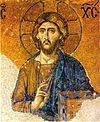
Autocephalous and
Autonomous churchesEparchies Greek Orthodox Archdiocese of Thyateira and Great Britain | Greek Orthodox Archdiocese of Italy and Exarchate of Southern Europe | Greek Orthodox Archdiocese of America | Greek Orthodox Archdiocese of Australia Syria topics
Syria topicsHistory Greater Syria · Ancient · Roman · Islamic · Ottoman · Arab Kingdom of Syria · French Mandate · Modern (2011 uprising)Government Arab Socialist Ba'ath Party (National Progressive Front) · Constitution · President · Vice President · Cabinet (Prime Minister, Ministries) · Parliament (Speaker) · Judiciary (Council, Supreme Court) · Military (Army, Air Force, Navy, Air Defense)Politics Geography Fertile Crescent · Governorates · Districts · Cities · Southern Syria · Hauran · Golan Heights · Al-Jazira · Syrian Desert · Anti-Lebanon mountains · Hermon · Euphrates · Orontes · VolcanoesInfrastructure Economy Society Culture Issues Portal Categories:- Religion in Syria
- Christianity in Syria
- Syrian Christians
Wikimedia Foundation. 2010.

